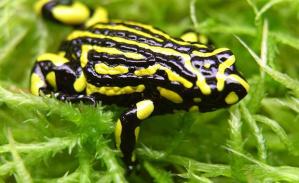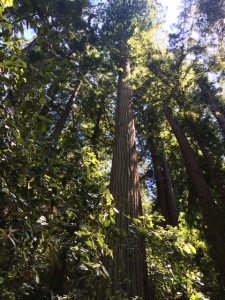 While I’ve blogged about this before in general terms (here and here), I thought it wise to reproduce the (open-access) chapter of the same name published in late 2013 in the unfortunately rather obscure book The Curious Country produced by the Office of the Chief Scientist of Australia. I think it deserves a little more limelight.
While I’ve blogged about this before in general terms (here and here), I thought it wise to reproduce the (open-access) chapter of the same name published in late 2013 in the unfortunately rather obscure book The Curious Country produced by the Office of the Chief Scientist of Australia. I think it deserves a little more limelight.
—
As I stepped off the helicopter’s pontoon and into the swamp’s chest-deep, tepid and opaque water, I experienced for the first time what it must feel like to be some other life form’s dinner. As the helicopter flittered away, the last vestiges of that protective blanket of human technological innovation flew away with it.
Two other similarly susceptible, hairless, clawless and fangless Homo sapiens and I were now in the middle of one of the Northern Territory’s largest swamps at the height of the crocodile-nesting season. We were there to collect crocodile eggs for a local crocodile farm that, ironically, has assisted the amazing recovery of the species since its near-extinction in the 1960s. Removing the commercial incentive to hunt wild crocodiles by flooding the international market with scar-free, farmed skins gave the dwindling population a chance to recover.
 Conservation scientists like me rejoice at these rare recoveries, while many of our fellow humans ponder why we want to encourage the proliferation of animals that can easily kill and eat us. The problem is, once people put a value on a species, it is usually consigned to one of two states. It either flourishes as do domestic crops, dogs, cats and livestock, or dwindles towards or to extinction. Consider bison, passenger pigeons, crocodiles and caviar sturgeon.
Conservation scientists like me rejoice at these rare recoveries, while many of our fellow humans ponder why we want to encourage the proliferation of animals that can easily kill and eat us. The problem is, once people put a value on a species, it is usually consigned to one of two states. It either flourishes as do domestic crops, dogs, cats and livestock, or dwindles towards or to extinction. Consider bison, passenger pigeons, crocodiles and caviar sturgeon.
As a conservation scientist, it’s my job not only to document these declines, but to find ways to prevent them. Through careful measurement and experiments, we provide evidence to support smart policy decisions on land and in the sea. We advise on the best way to protect species in reserves, inform hunters and fishers on how to avoid over-harvesting, and demonstrate the ways in which humans benefit from maintaining healthy ecosystems.
Homo sapiens is a relatively new addition to the global species pool collectively called ‘biodiversity’. Like other species and physical processes before us, we have changed our planet’s biosphere in a geological heartbeat. Many geologists argue that the planet has entered a new geological era – the Anthropocene – which is characterised by the human-caused signal of mass extinction above the normal rate at which species vanish.
Extinction generally comes in waves – so-called mass extinction events. Prior to the Anthropocene, five mass extinction events have occurred since the Cambrian period about 500 million years ago. The Permian extinction (250 million years ago) was the worst. Roughly 95 per cent of all species on Earth disappeared. The most infamous mass extinction happened about 65 million years ago during the Cretaceous period when a giant asteroid struck Earth, killing off most dinosaurs.
But the Anthropocene shows extinction rates exceeding the background rate – the rate between mass events – by up to 10000 times. Of course, scientists debate the true inflation factor due to the difficulty of observing extinctions. (See: Box 1: Counting species one by one). Regardless, it’s clear the planet is losing biodiversity at an alarming rate.
| Box 1: Counting species one by one |
| It is easy to be impressed when considering the variety of life on Earth, known collectively as biodiversity. Conservative estimates place the number of species in different groups living today at more than 4 million protists – eukaryotic microorganisms with a cell nucleus – 75 000-300 000 helminth (worm) parasites; 1.5 million fungi, 320 000 plants, 4-6 million arthropods (insects and the like), 30 000 fishes, 6500 amphibians, 10 000 reptiles, 10 000 birds and around 5000 mammals.
While scientists are confident they have inventoried most of the larger species, such as mammals and birds, estimates of the number of smaller, more cryptic species are highly uncertain. In fact, total estimates range from only several million to several hundred million species worldwide. Both extremes seem unlikely. The term biodiversity itself is a variable concept. The simplest way of estimating it is to count the number of species within a given area. But this belies its complexity. Biodiversity includes, among many other things, genetic diversity, ecological function, and the way in which species’ composition changes over space and time. Simply adding up the number of species, therefore, ignores important factors like ‘endemism’ – species found nowhere else – rarity, genetic variation, resilience, and evolutionary potential, and the ability to adapt to environmental change by evolving. It’s hardly surprising that people often have difficulty grasping the importance and complexity of biodiversity, especially considering our increasingly nature-disconnected lifestyles. Another important aspect of biodiversity is how much of it is disappearing, and at what rate. Extinction might appear obvious because it ultimately involves comparing a time when a species was present to another when it is no longer. Unfortunately, it’s not that straightforward. Even the date of the infamous dodo extinction is uncertain, with claims it survived another 30 years beyond its last sighting. The problem lies in the fact that as population abundance declines it is more difficult to detect remaining individuals, especially in the case of already rare and cryptic species. For example, would anyone even notice if a rare species of underground fungus went extinct? The answer is: only if someone had already been documenting its distribution and decline. Expand that to the millions of species on the planet, combined with the uncertainty associated with that number itself, and it |
Given the realities of daily life, it’s easy to forget that biodiversity is important to our wellbeing. Australians feel they are in touch with the bush, but the fact is most do not appreciate the natural world on which they utterly depend.
It’s not hyperbole, naïveté or green platitudes – all people depend absolutely on every other species. For instance, consider the very air we breathe. Nearly all the oxygen in the atmosphere is produced by plants and much of that by marine algae. Yet worldwide we treat oceans like giant toilets and cut down forest blocks every year that, together, equal the size of Tasmania.
On the topic of plant respiration – the process of photosynthesis in which plants take up carbon dioxide and release oxygen – the world is now faced with centuries of tumultuous climate disruption from industrial emissions, yet more than a third of the world’s carbon is stored in forests. In other words, more forests equals less carbon dioxide in the atmosphere and slower, less intense climate change.
Much of the food grown to feed the seven billion-strong human population is pollinated by a wide array of animals, and most of that is done by a single species – the honeybee. Yet bee populations around the world are crashing because of forest fragmentation and our overuse of pesticides. No pollination, fewer crops. And most of the world’s drinking water comes mainly from natural waterways and wetlands that filter out the contaminants people produce.
 Other examples of ‘ecosystem services’ abound. Even the much-maligned shark is an essential ecosystem engineer. Wherever shark populations are abundant and diverse, reefs are healthier, fish populations are higher and water clarity is better.
Other examples of ‘ecosystem services’ abound. Even the much-maligned shark is an essential ecosystem engineer. Wherever shark populations are abundant and diverse, reefs are healthier, fish populations are higher and water clarity is better.
This happens because large sharks impose a top-down pressure on smaller predators, thus limiting the latter’s intake of other fish species. Removing the biggest predators means that smaller predators increase, which then quickly eat other species that keep things like algae in check. The overall effect is a biologically poor system, prone to further degradation.
Even the feared dingo plays an essential ecosystem role. Wherever scientists have looked, areas with large dingo populations have more native marsupials. Where dingos are poisoned or fenced out, native mammals do not do well.
Why? Dingoes outcompete and kill introduced cats and foxes. Australia’s estimated 18 million feral cats, in particular, are a biodiversity scourge. To illustrate, imagine a line of stock trucks bumper-to-bumper along the 600 kilometres from Sydney to Grafton. Each is filled to the brim with native animals: possums, bandicoots, penguins, lizards, skinks and so forth. This represents how many native animals are killed each year by feral cats. Little wonder then that Australia has the world’s worst record for mammal extinctions.
If one considers the totality of all these different interactions, dependencies and functions – the scientific discipline of ecology – the logical conclusion is that all biodiversity can be considered under the umbrella of ‘biowealth’.
 This concept encapsulates the two most important elements of biodiversity from a human perspective. The first is that diversity is an essential requirement for life. Without all, or at least most, of these species, we humans inevitably lose important services. Secondly, this diversity provides humanity – largely free of charge – with the elements essential for survival. Without biodiversity we are poor. With it we are ‘biorich’.
This concept encapsulates the two most important elements of biodiversity from a human perspective. The first is that diversity is an essential requirement for life. Without all, or at least most, of these species, we humans inevitably lose important services. Secondly, this diversity provides humanity – largely free of charge – with the elements essential for survival. Without biodiversity we are poor. With it we are ‘biorich’.
So consider the crocodiles, sharks and snakes, the small and the squirmy, the smelly, slimy and scaly. Consider the fanged and the hairy, the ugly and the cute alike. The more we degrade this astonishing diversity of evolved life and all its interactions on our only home, the more we expose ourselves to the ravages of a universe that is inherently hostile to life.
It is time to embrace, protect and cherish Australia’s biowealth so our children can live happy, prosperous lives. It is time to build biodiversity into daily life by regularly reporting the state of the nation’s biowealth alongside economic, sport and stock market indices. Only then will society be cognisant of, and perhaps stimulated to improve, the state of Homo sapiens’ one and only life-support system.



[…] topic is on human health, which as I’ve written many times before, is in many ways linked to the quality of the environment in which people live. We are currently […]
LikeLike
Thanks for the interesting article! I couldn’t agree with you more. One quick typo: protists are eukaryotes, so they have a nucleus.
LikeLike
Oops. Nice spot. Corrected.
LikeLike
Wonderfully clear….thankyou for providing us all with the ‘obvious’ picture which we somehow manage to ignore as a species.
LikeLike
Thanks Corey, ‘Biowealth’ is an arresting concept and the connotations are all positive; we like wealth, especially in the commons – ‘diversity’ lacks this instant, recognisable connection. I’m going to steal your terminology…
LikeLike